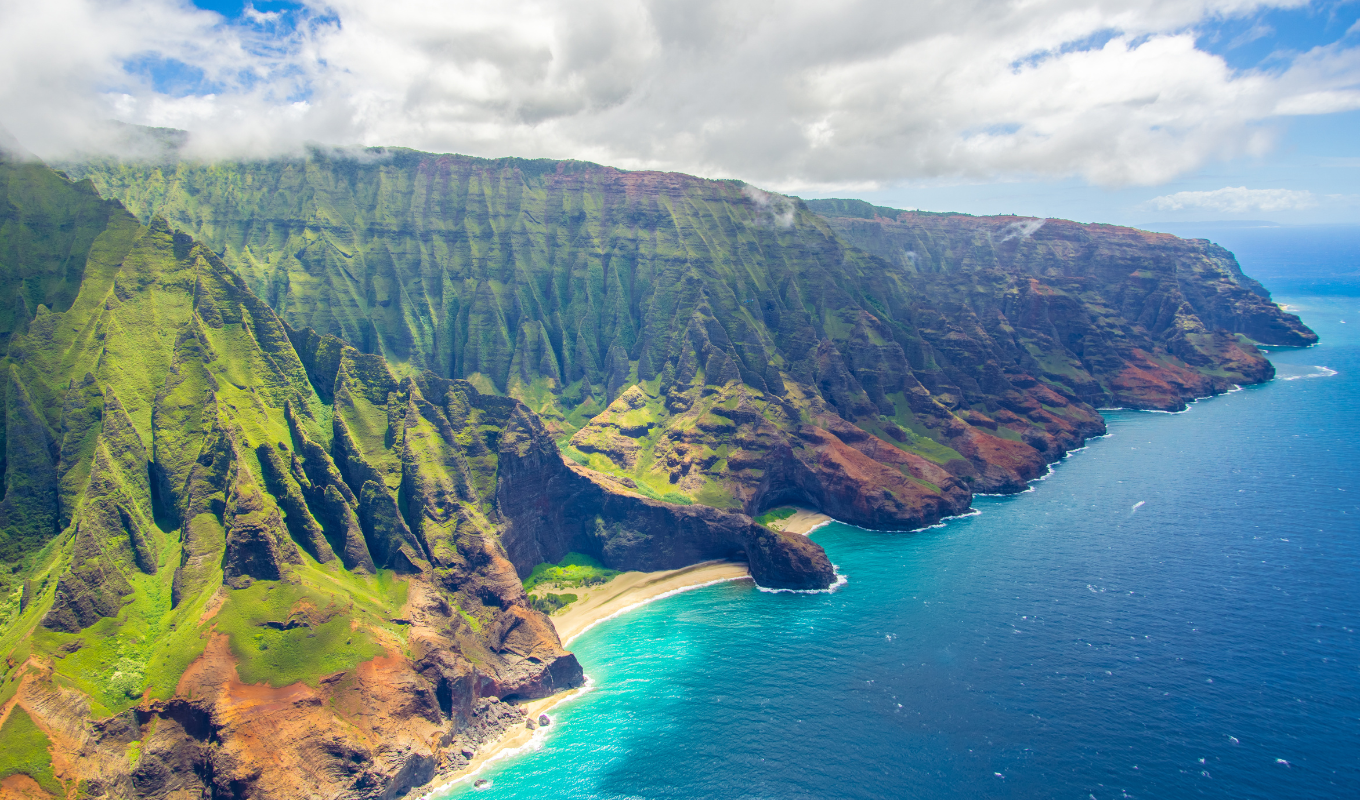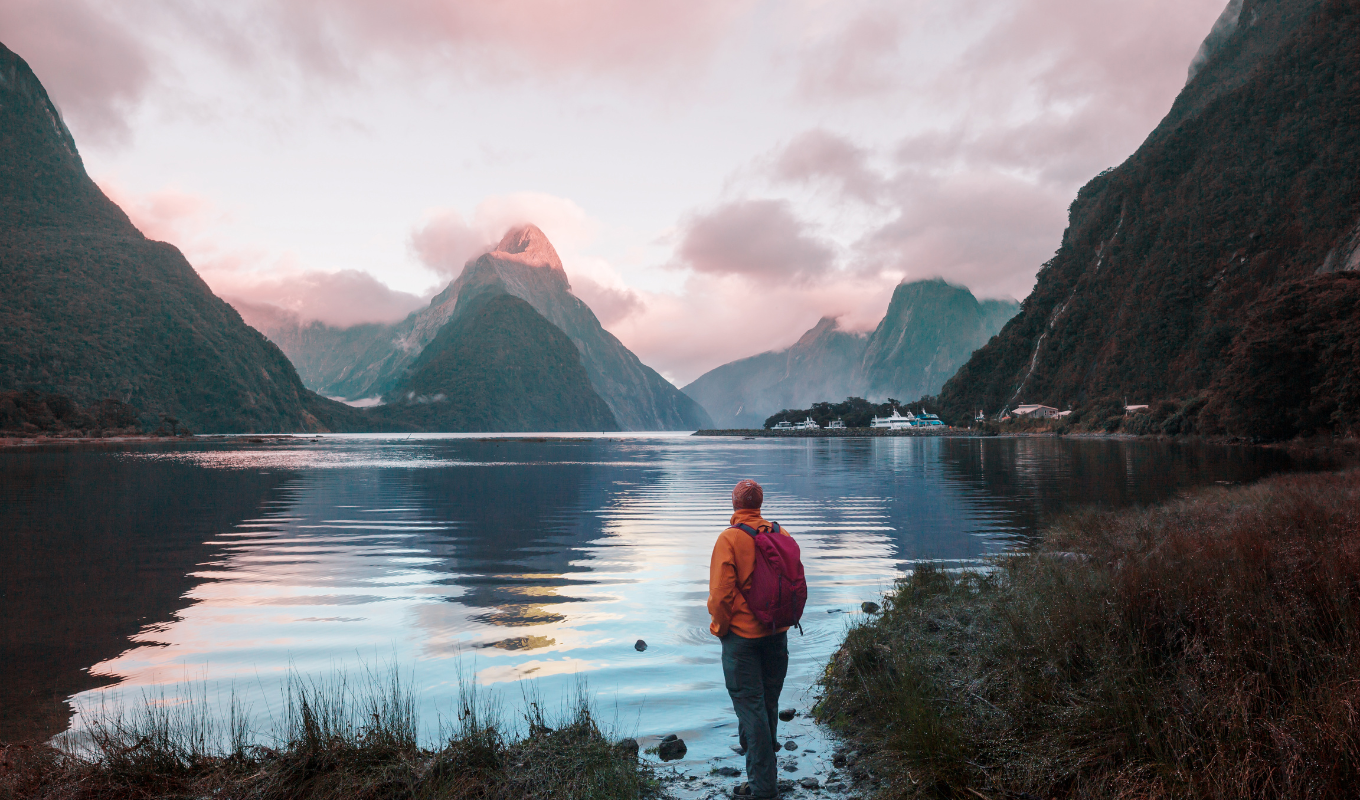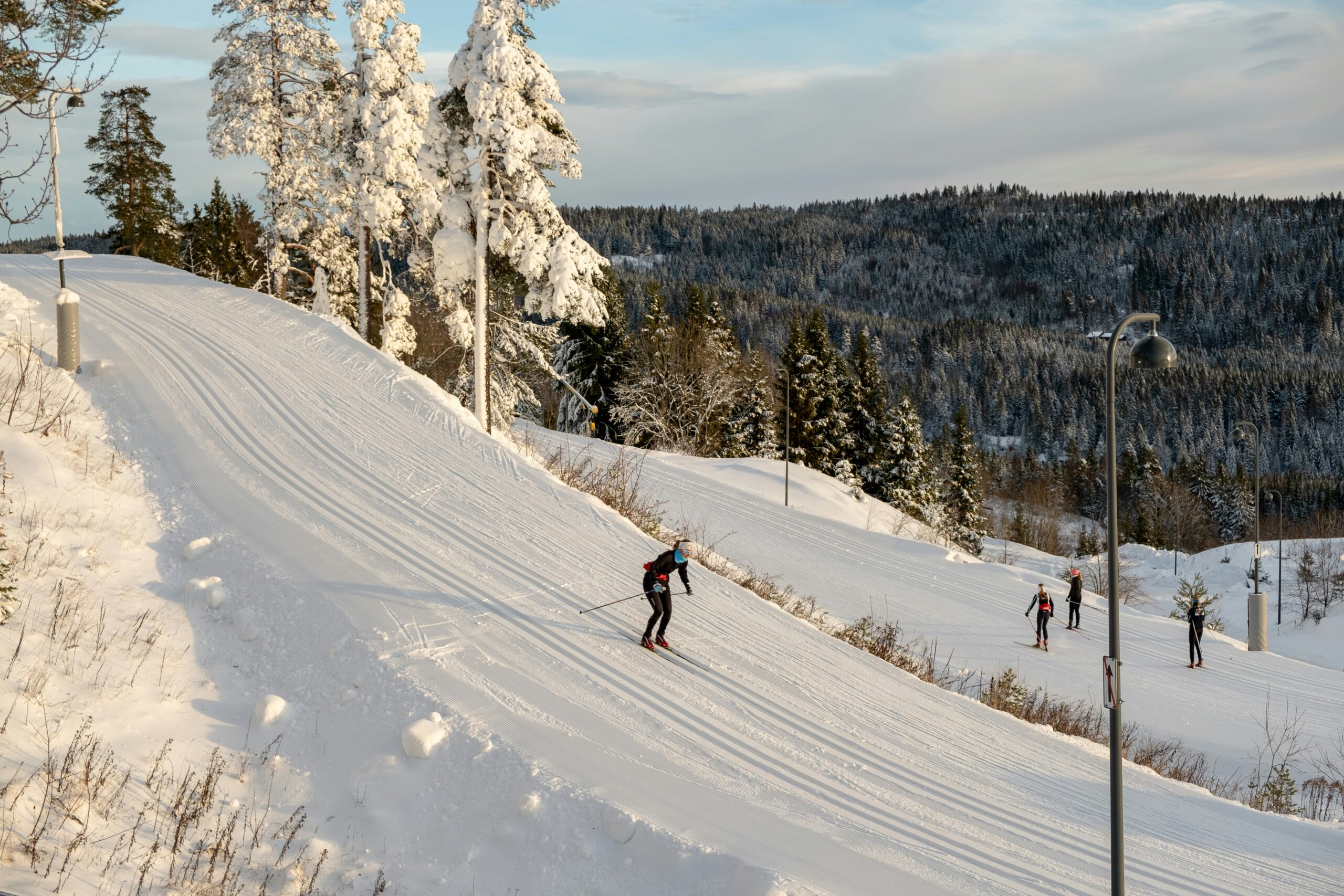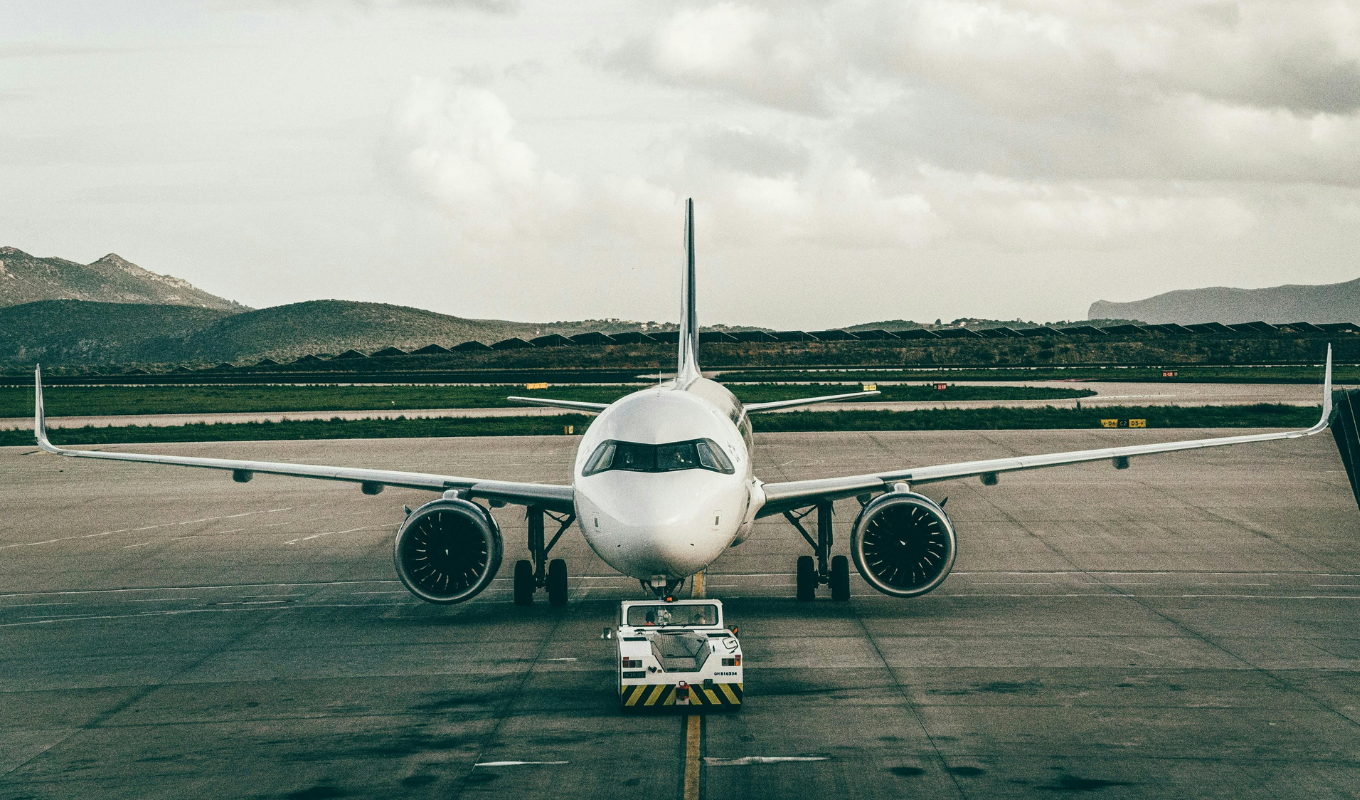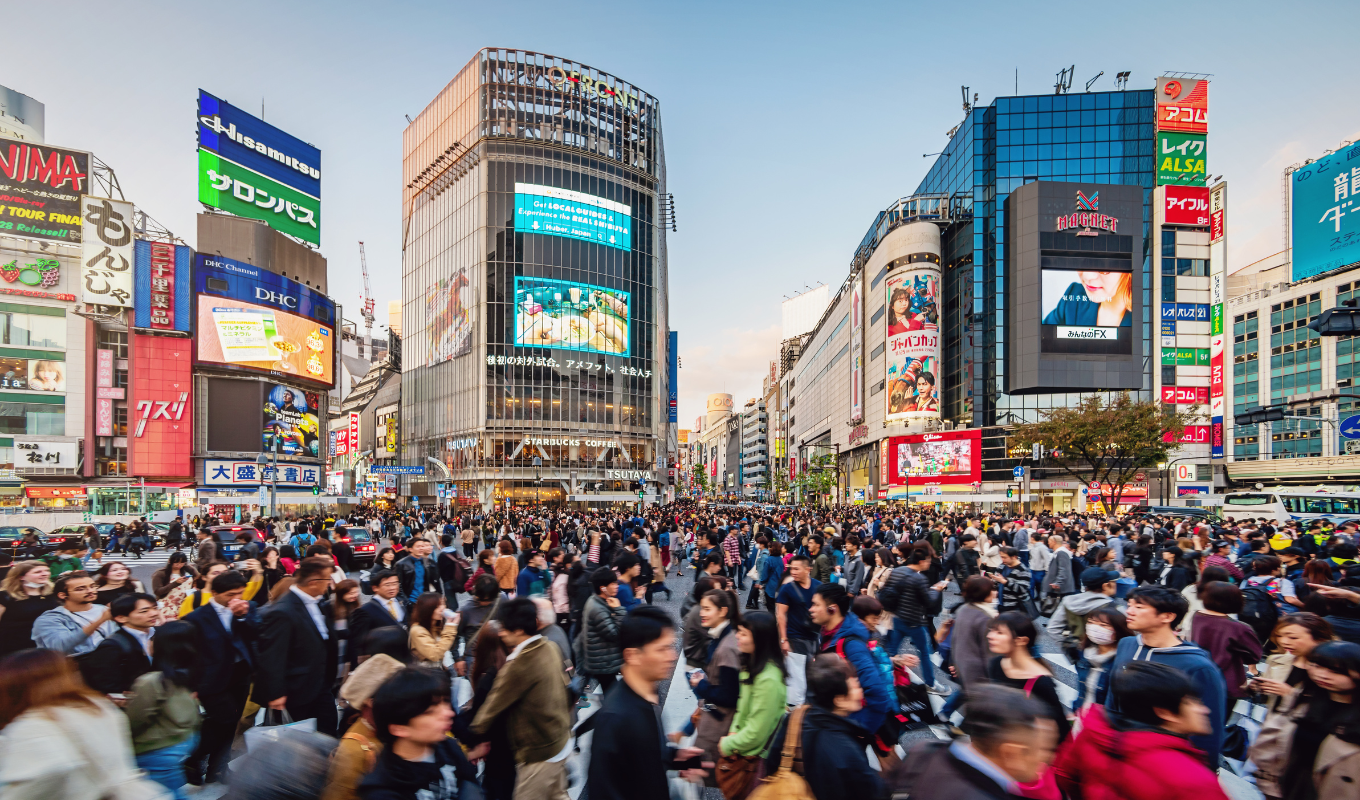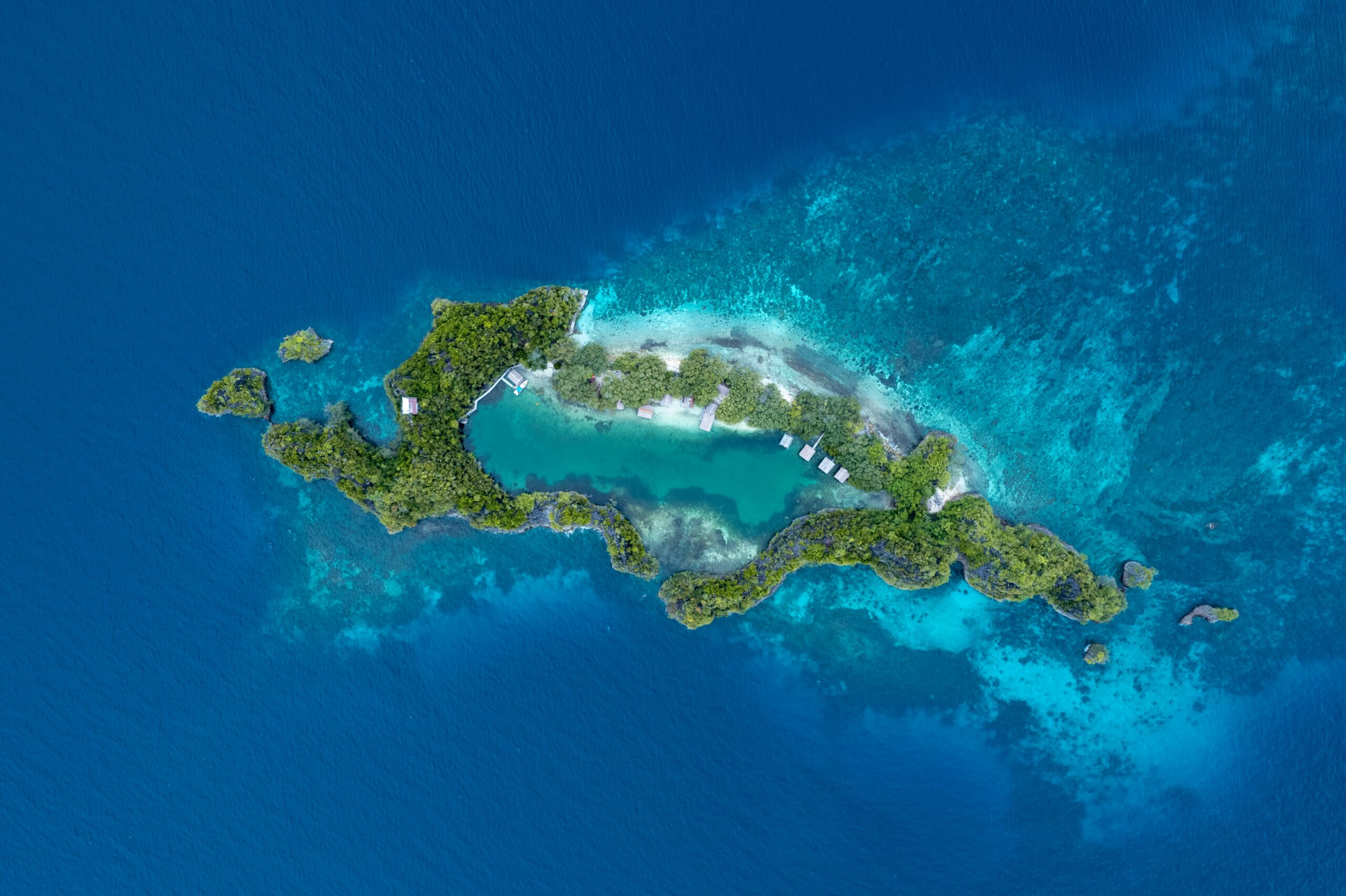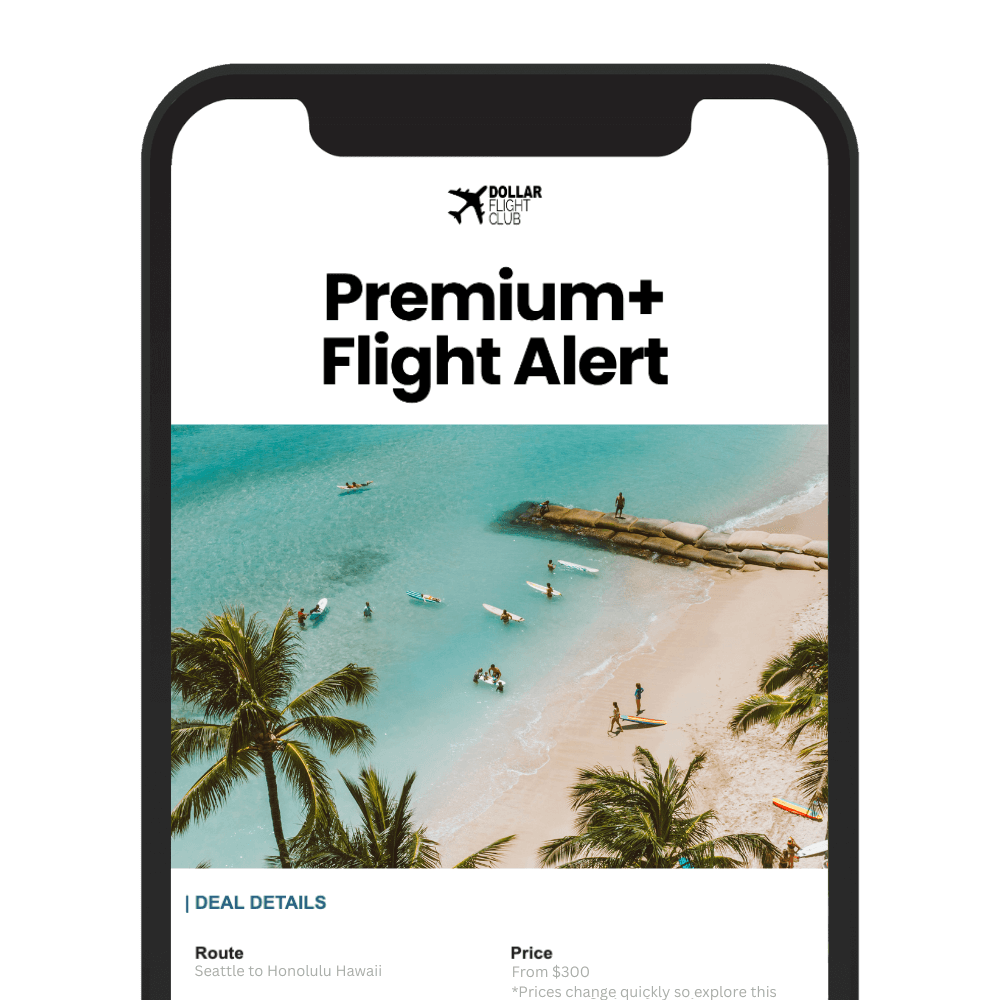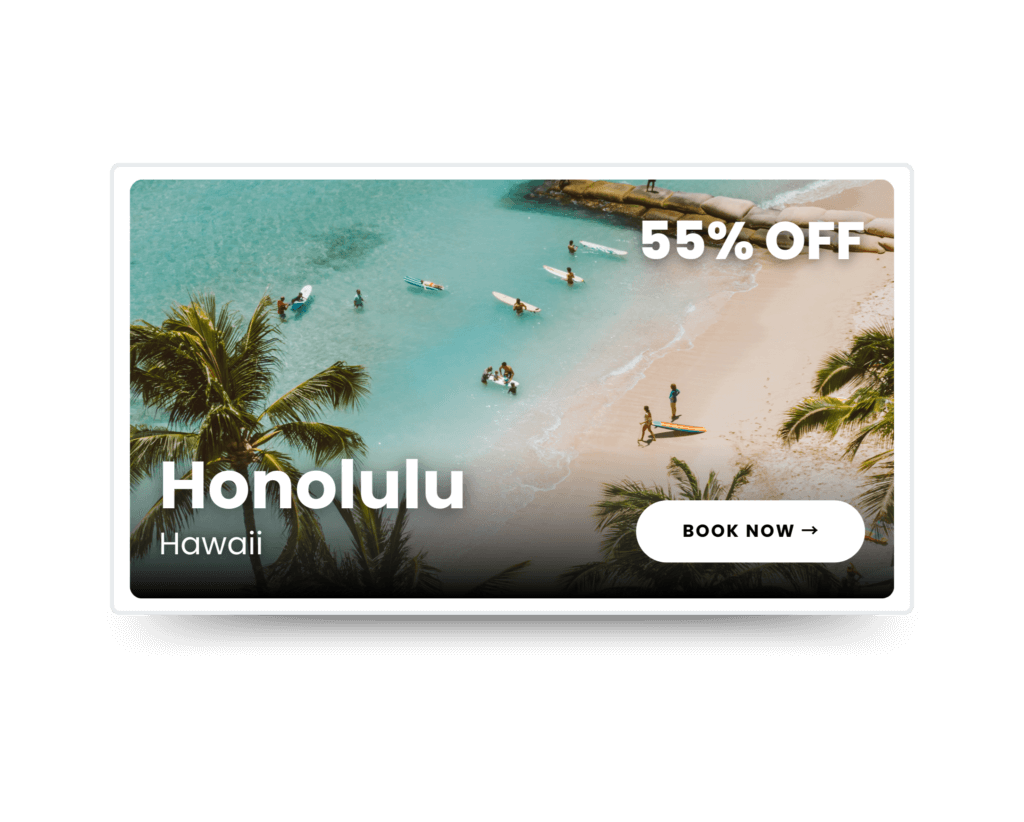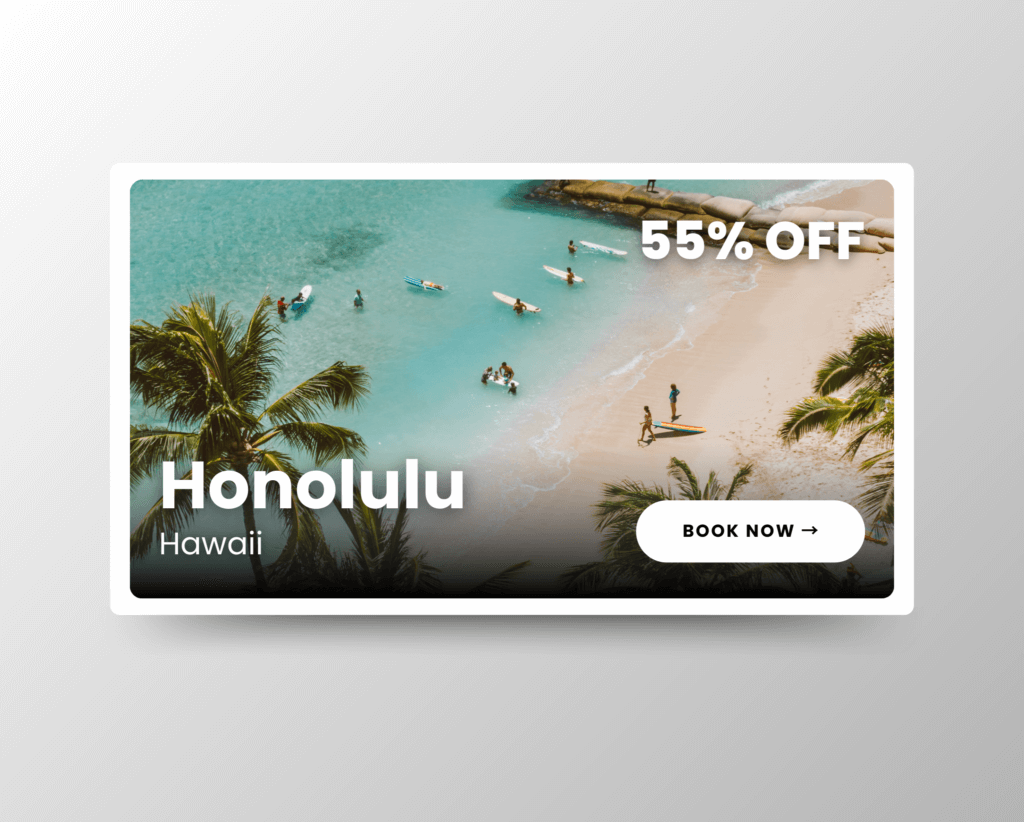Hawaii is a dream destination offering stunning beaches, volcanic landscapes, and rich traditions. Whether you’re planning a quick getaway or a multi-island trip, here’s what you need to know:
- Best Time to Visit: Shoulder seasons (April–June, September–December) offer fewer crowds, better weather, and lower prices. Peak times (December–March, June–August) are busier and more expensive.
- Top Islands:
- Oʻahu: Famous for Waikiki Beach, Pearl Harbor, and lively city vibes.
- Maui: Known for Haleakalā sunrise, Road to Hana, and whale watching.
- Kauaʻi: Features lush rainforests, Waimea Canyon, and the Nāpali Coast.
- Big Island: Home to active volcanoes, black sand beaches, and stargazing at Mauna Kea.
- Travel Tips:
- Book flights early, especially during off-peak times, for deals as low as $200 from the West Coast.
- Inter-island travel is best done via short flights with Hawaiian Airlines.
- Renting a car is essential on most islands for exploring remote areas.
- Food Highlights: Try poke, shave ice, kalua pig, and malasadas. Food trucks and plate lunch spots are affordable options.
- Activities: Don’t miss snorkeling at Molokini Crater, hiking Diamond Head, and exploring Hawaiʻi Volcanoes National Park.
Plan ahead to secure deals on flights, accommodations, and activities. Hawaii’s mix of relaxation and adventure ensures a memorable trip.
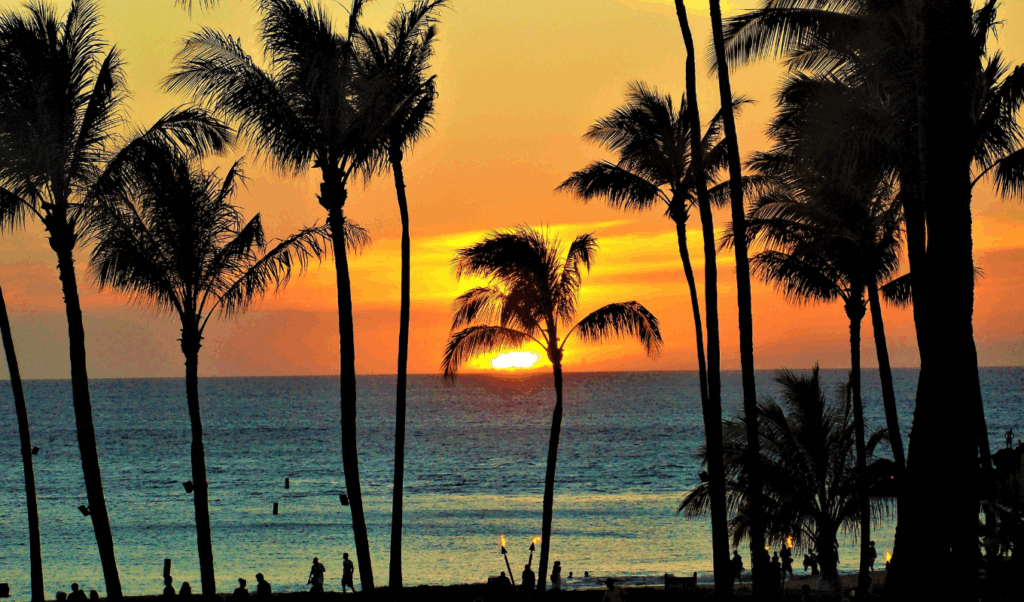
When to Visit Hawaii
Hawaii’s tropical climate makes it a year-round destination, but knowing the seasonal trends can help you plan a trip that suits your budget, preferences, and desired experiences – whether you’re chasing sunny beach days, avoiding crowds, or catching a cultural event.
Weather and Seasons
Hawaii enjoys consistent temperatures throughout the year, generally staying between 60°F and 90°F. The islands have two main seasons: a drier period from April to October and a wetter season from November to March.
During the dry season (summer), temperatures typically hover between 75°F and 85°F, accompanied by refreshing trade winds. Rainfall is minimal, averaging just 0.5 inches per month on the leeward (west and south) sides, making it ideal for beach lovers and those seeking calm ocean conditions.
The wet season (winter) is slightly cooler, with temperatures ranging from 68°F to 78°F. Rain becomes more frequent, especially on the windward (north and east) sides, but it usually falls in short, heavy bursts. Winter also brings larger swells to the north shores, creating prime surfing conditions but potentially rougher waters for swimmers.
Hawaii’s microclimates add another layer of variety. For example, the Big Island’s highlands can be cooler, while Kauaʻi’s interiors see heavier rainfall. These differences can shape your travel plans, as well as influence pricing and crowd levels.
Peak, Shoulder, and Off-Peak Travel Times
Knowing Hawaii’s travel patterns can help you save money and avoid the busiest times. The peak season stretches from mid-December through March and June through August, aligning with school vacations and winter getaways. During these periods, resort rates can jump by as much as 60%, and flights from the mainland may cost $200-400 more.
Shoulder seasons – April to mid-June and September to mid-December – strike a great balance. You’ll enjoy warm weather, lighter crowds, and savings of 20-30% on accommodations and flights. These months are perfect for travelers seeking a more relaxed experience without sacrificing good weather.
For budget-conscious travelers, the off-peak period from late January to March (excluding holiday weekends like Presidents’ Day) offers the best deals. While rain showers are more common, they’re usually short-lived and followed by sunshine. This is also the time when you’ll find easier access to top restaurants and attractions without needing to book far in advance.
If you’re hunting for cheap flights, services like Dollar Flight Club can notify you of mistake fares and flash sales, with round-trip tickets from West Coast cities sometimes dropping to $200-300 – especially during off-peak times.
Festivals and Events
Hawaii’s vibrant events calendar offers unique ways to enrich your visit, though popular festivals can impact pricing and availability. The Merrie Monarch Festival in Hilo every April is a must-see for hula enthusiasts, often referred to as the “Olympics of hula.” This week-long event attracts thousands, so hotels fill up quickly, and prices rise accordingly.
The Aloha Festivals, held across all islands in September and October, feature parades, traditional crafts, and Hawaiian music. Since these events align with the shoulder season, it’s a great time to experience Hawaiian traditions without battling peak-season crowds.
From December to April, whale watching season brings thousands of humpback whales to Hawaiian waters. Maui is a prime spot for sightings, and many tours guarantee you’ll see these majestic creatures.
Surfing fans should consider visiting Oʻahu’s North Shore in November or December for the Vans Triple Crown of Surfing, where world-class surfers compete at iconic spots like Pipeline and Sunset Beach. While accommodations in the area may be pricier, the experience of witnessing professional surfing is unforgettable.
Lei Day, celebrated on May 1st, offers a quieter cultural experience with lei-making contests and demonstrations across the islands. It’s a wonderful way to connect with Hawaiian traditions without the crowds or price hikes of larger festivals.
Food lovers might plan their trips around events like Maui’s Kapalua Wine & Food Festival in June or the Big Island’s Kona Coffee Cultural Festival in November. These gatherings highlight Hawaii’s culinary scene and provide opportunities to meet local chefs and producers, adding a delicious layer to your itinerary.
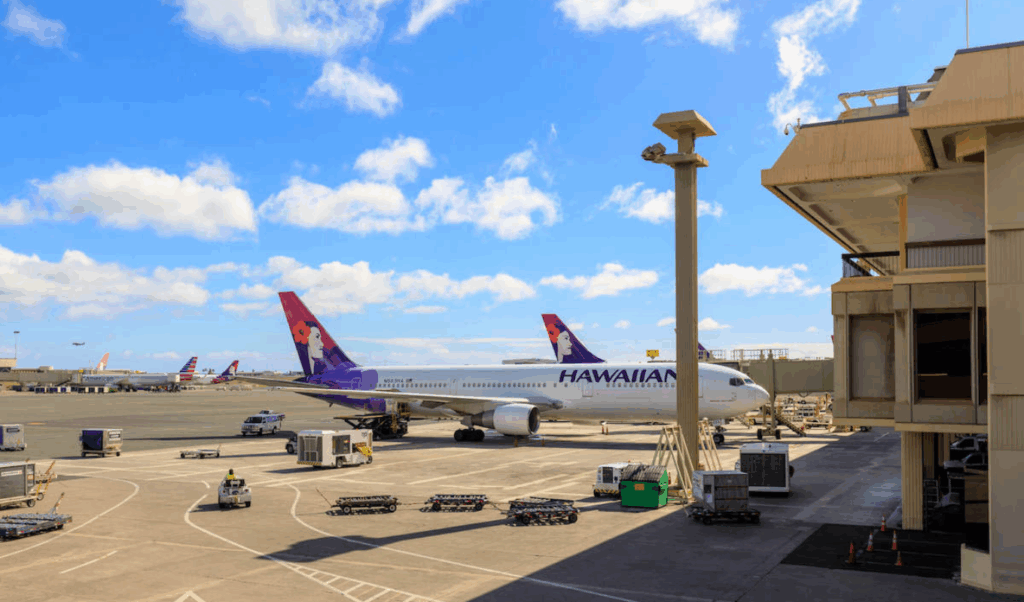
How to Get to Hawaii
Flying is the only practical way to reach Hawaii from the mainland. With some planning and smart strategies, you can snag affordable fares and turn your dream Hawaiian getaway into a reality without breaking the bank.
Finding Cheap Flights
Flight prices to Hawaii can vary widely depending on when you book, where you’re flying from, and how flexible you are with your travel plans. Booking several months in advance and opting for weekday or red-eye flights can often save you money.
If you’re open to adjusting your travel dates, you might find significant savings. For instance, traveling during less busy times – like late January through March – often results in lower prices.
Another tip? Sign up for flight deal alerts. Services like Dollar Flight Club can notify you about mistake fares or flash sales, offering substantial discounts on round-trip tickets from West Coast cities. Their Premium+ membership ($99/year) even includes alerts for international flights, business class deals, and SMS notifications for time-sensitive offers.
Mistake fares, while rare and unpredictable, can result in huge savings if you act quickly. Additionally, if you’re planning to visit multiple islands, consider flying into one island and departing from another to maximize savings and convenience. Your departure city can also play a big role in finding the best deals.
Major U.S. Departure Cities
West Coast cities are your best bet for affordable and frequent flights to Hawaii. Los Angeles International (LAX) is a key hub, offering multiple daily connections to Hawaii’s major airports. Round-trip fares from LAX can vary greatly depending on whether you’re traveling during peak or off-peak seasons.
San Francisco (SFO) and Seattle (SEA) are also excellent choices. San Francisco benefits from high business travel volume, while Seattle offers strong service from several airlines on popular routes.
If you’re farther inland, major hubs like Dallas (DFW) or Phoenix (PHX) often feature competitive fares. Phoenix, in particular, has gained popularity thanks to direct services from airlines like Southwest. Other cities like Denver, Chicago, and Atlanta also offer direct flights, though prices are typically higher than those from West Coast hubs.
For East Coast travelers, flights take longer and tend to cost more. Still, direct flights are available from cities like New York (JFK), Boston (BOS), and Washington D.C. (DCA). Shoulder seasons often bring better pricing for these routes. Flight durations range from about 5–6 hours from the West Coast to up to 11 hours from the East Coast. Before booking, make sure to check travel documentation and regulations.
Travel Requirements
U.S. citizens only need a government-issued photo ID for domestic travel to Hawaii.
For international visitors, standard U.S. entry requirements apply. This includes a valid passport and, for many countries, a visa or authorization through the Visa Waiver Program (ESTA). The ESTA application costs $21, so apply early to avoid delays.
Hawaii has strict agricultural rules to safeguard its unique ecosystem. Fresh fruits, vegetables, and plants from the mainland are generally prohibited, though packaged and processed foods are usually fine. It’s a good idea to check the latest regulations before packing.
Similarly, when leaving Hawaii, certain items – like fresh leis, some fruits, or plants – may need to pass an agricultural inspection before being brought back to the mainland. Items like coffee beans and macadamia nuts are typically allowed.
While most COVID-19 restrictions have been lifted, check current health guidelines before your trip.
Travel insurance is optional but highly recommended, especially to protect against weather-related delays or other unexpected disruptions. Many credit cards offer travel protection, so review your card’s benefits before purchasing additional coverage.
Lastly, keep Hawaii’s time zone in mind when planning your trip. The state operates on Hawaii-Aleutian Standard Time year-round, which is 2 to 3 hours behind Pacific Time, depending on the season. This can be important when scheduling flights or planning your arrival.
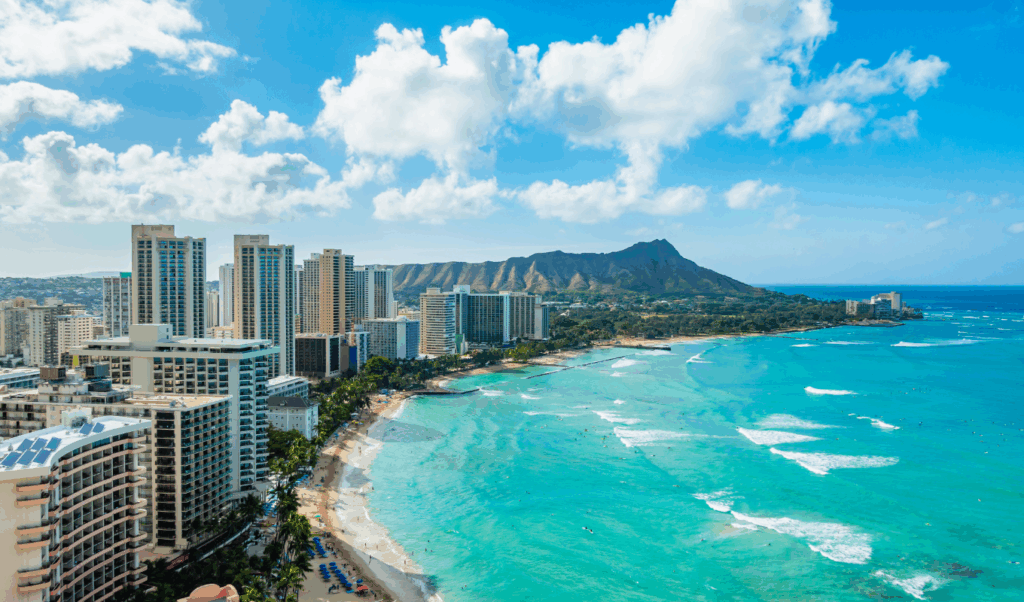
Where to Stay in Hawaii
Your choice of lodging can shape your Hawaiian adventure. Whether you’re drawn to luxurious oceanfront resorts or prefer the charm of a cozy vacation rental, Hawaii has accommodations for every budget and travel style. What matters most to you – personalized service, privacy, location, or affordability – will guide your decision. Where you stay sets the tone for exploring the islands with ease.
Hotels, Resorts, and Vacation Rentals
Hawaii’s hospitality scene is as diverse as its landscapes. Hotels and resorts, especially in bustling areas like Waikīkī on Oʻahu or the upscale corners of Maui, offer daily service and amenities like pools, spas, and on-site dining. If you’re looking for more space and the convenience of a kitchen, vacation rentals are a great option, particularly for longer stays.
When choosing where to stay, consider proximity to the activities and attractions that interest you most.
Best Areas by Island
Each Hawaiian island has its own personality, and where you stay can enhance your experience.
- Oʻahu: Waikīkī is the heart of the island’s tourism, known for its lively shopping, dining, and nightlife. For a more relaxed atmosphere, the North Shore offers a slower pace and access to world-famous surf spots.
- Maui: Perfect for blending adventure with relaxation, West Maui (Kāʻanapali, Kapalua) is home to luxurious resorts and pristine beaches. Other parts of the island provide a variety of lodging options to suit different tastes.
- Kauaʻi: Known as the “Garden Isle”, Kauaʻi offers a mix of family-friendly resorts and secluded retreats. The South Shore around Poipū is a favorite for its sunny weather and laid-back vibe, while the North Shore near Princeville boasts dramatic clifftop views and easy access to breathtaking scenery.
- The Big Island: With its vast size and diverse climates, planning is key. The Kona area on the west side is popular for its sunny weather and rich local culture, while Hilo on the east side offers lush greenery and proximity to natural wonders.
No matter which island you choose, the right location will make your Hawaiian experience unforgettable.
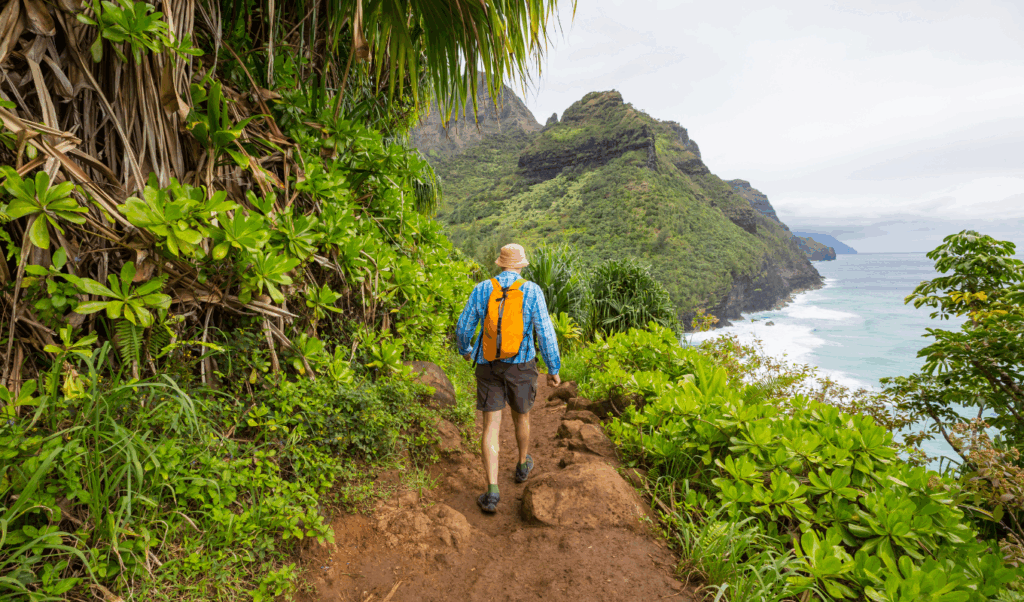
Getting Around the Islands
Exploring Hawaii’s islands and moving between them calls for some planning, as transportation options vary based on your budget, schedule, and how much freedom you want during your trip.
Inter-Island Flights and Ferries
For quick and easy island hopping, Hawaiian Airlines is your go-to option. They operate numerous daily flights connecting all the major islands, with flight times that are short enough to make the process smooth and convenient.
If you’re looking for an alternative, ferries like Expeditions Ferry provide service between Maui and Lānaʻi or Maui and Molokaʻi. While ferries can be a scenic way to travel, flights are generally more frequent and reliable, making them the more practical choice for most travelers.
Once you’re on an island, you’ll need to figure out how to get around. Let’s dive into the local options.
Ground Transportation
If you want the freedom to explore at your own pace, renting a car is often the best choice. This is especially true on the Big Island and Kauaʻi, where attractions are spread out and public transit options are limited. Make sure to book your rental car in advance, especially during busy travel seasons.
On the Big Island, a rental car is almost essential because of the island’s size and the wide range of attractions spread across different climate zones. Keep in mind, though, that some rental agencies restrict driving to certain areas, like the Mauna Kea summit or Green Sand Beach, due to rough road conditions.
Public transportation varies by island. Oʻahu stands out with its extensive TheBus system, which connects key areas like Honolulu, Waikīkī, and major attractions for just $3 per ride. On the Big Island, the Hele On Bus is free but runs less frequently and serves fewer destinations.
Rideshare options like Uber and Lyft are available on Oʻahu and the Big Island, offering a convenient choice for airport transfers or evening outings. If you’re not keen on driving, guided tours with hotel pickups can also be a great way to see the sights without the hassle of navigating.
Island-Specific Transportation Tips
Each island has unique transportation quirks, so here’s a closer look at what to expect:
- Oʻahu: With its well-developed transit system, Oʻahu makes it easy to get around without a car, especially in urban areas like Honolulu. Parking in the city can be expensive and hard to find, so if you’re staying in Waikīkī and sticking to urban attractions, using TheBus is a smart move. For more remote spots, however, a rental car might be necessary.
- Big Island: Given its massive size and scattered attractions, renting a car is highly recommended here. While Hele On Bus exists, it’s not ideal for reaching key destinations like Hawaiʻi Volcanoes National Park or areas with unique microclimates.
- Kauaʻi: Public transit is minimal on this island, so a rental car is almost a must if you want to explore its natural wonders. Even though the island is smaller, reserving a car early – especially during peak travel times – is a good idea.
- Maui: Maui strikes a balance, offering some public transportation options, but a rental car is still the best way to explore. Whether you’re driving the Road to Hāna, visiting Haleakalā National Park, or seeking out hidden beaches, having your own vehicle gives you the flexibility to go at your own pace. Just be aware of potential traffic in resort areas during busy hours.
Ultimately, your choice of transportation will depend on your travel style, budget, and the activities you have planned. While rental cars often come with an upfront cost, they can open up opportunities to discover off-the-beaten-path spots that tours might miss.
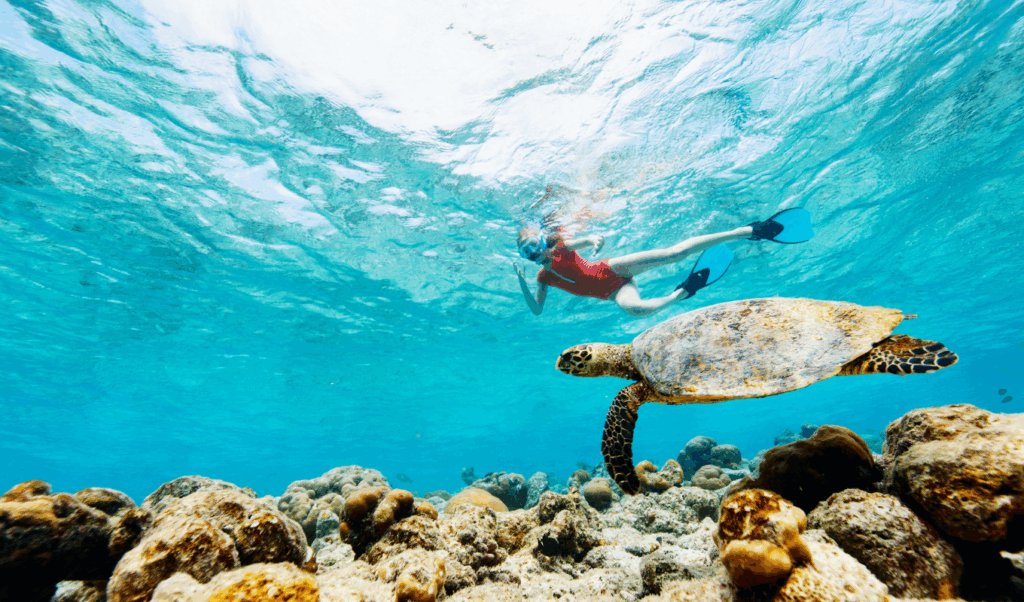
Top Attractions and Activities
Hawaii’s islands offer an incredible mix of experiences, from exploring historic landmarks to marveling at natural wonders. Whether you’re craving a laid-back beach day or an action-packed adventure, there’s something for everyone. Many of these highlights are easily accessible, especially with the transportation tips mentioned earlier.
Oʻahu Highlights
Waikīkī Beach is a favorite spot for beginner surfers and anyone drawn to a lively beachfront vibe. Its iconic shoreline is perfect for soaking up the sun or catching your first wave.
At Pearl Harbor, you’ll step into one of the most important chapters of American history. The USS Arizona Memorial honors the events of World War II, and the site also features historic naval vessels and museums. Since same-day tickets can be scarce, booking in advance is a smart move. Visiting during quieter hours can make the experience even more meaningful.
For a short but rewarding hike, head to Diamond Head Crater, where sweeping views of Honolulu and the Pacific Ocean await. Starting early not only beats the crowds but also helps you avoid the midday heat.
If you’re looking for adventure with a touch of cinematic charm, Kualoa Ranch is the place to be. Known for its breathtaking valleys, this spot offers off-road tours and horseback riding, blending natural beauty with a dash of Hollywood history.
The Polynesian Cultural Center in Laie is a vibrant celebration of Pacific island cultures. Explore interactive villages, enjoy traditional performances, and even hop on a canoe ride for a fun and educational experience.
Maui Adventures
Maui delivers a perfect mix of natural beauty and historical charm, making it a must-visit destination.
Start your day early at Haleakalā National Park to catch the sunrise from the summit – an experience you won’t forget. Be sure to secure reservations ahead of time and dress in layers, as the elevation brings cooler temperatures.
The Road to Hāna is a journey in itself, winding along Maui’s coastline with stops at waterfalls, a black sand beach, and serene pools. Set aside a full day to take in all its hidden gems, and don’t forget your camera.
For snorkeling enthusiasts, Molokini Crater is a dream spot. This partially submerged volcanic caldera is teeming with vibrant marine life, making it a top choice for underwater exploration.
The historic town of Lahaina offers a blend of art galleries, delicious dining, and a glimpse into Maui’s past. Its charm is irresistible, whether you’re strolling along Front Street or learning about its rich history.
Winter visitors will love Maui’s whale-watching opportunities, while the Maui Ocean Center provides an up-close look at Pacific marine life through engaging exhibits.
Kauaʻi and Big Island Must-Sees
Kauaʻi and the Big Island each bring their own unique landscapes to the table, from rugged coastlines to volcanic marvels.
Kauaʻi’s Nāpali Coast is a showstopper with its towering sea cliffs, hidden beaches, and cascading waterfalls. Whether you explore it by helicopter, boat, or on a challenging hike, the views are nothing short of spectacular.
Nicknamed the “Grand Canyon of the Pacific”, Waimea Canyon features striking red rock formations and lush valleys. Multiple lookout points provide jaw-dropping vistas that are well worth the trip.
On the Big Island, Hawaiʻi Volcanoes National Park is a must-visit for its active volcanic landscapes. Highlights include Kīlauea, one of the world’s most active volcanoes, and scenic drives that reveal lava tubes and craters.
Mauna Kea offers some of the best stargazing you’ll ever experience. As one of the tallest mountains when measured from its ocean floor base, it’s a favorite for astronomy enthusiasts. Keep in mind, though, that reaching higher elevations often requires a four-wheel-drive vehicle.
At Akaka Falls State Park, a short loop trail takes you through lush rainforest to the stunning Akaka Falls and nearby Kahuna Falls. It’s a perfect spot for capturing unforgettable photos.
Finally, Punaluʻu Black Sand Beach offers a striking contrast with its volcanic black sand. Keep an eye out for Hawaiian green sea turtles resting on the shore, but remember to admire them from a safe distance.
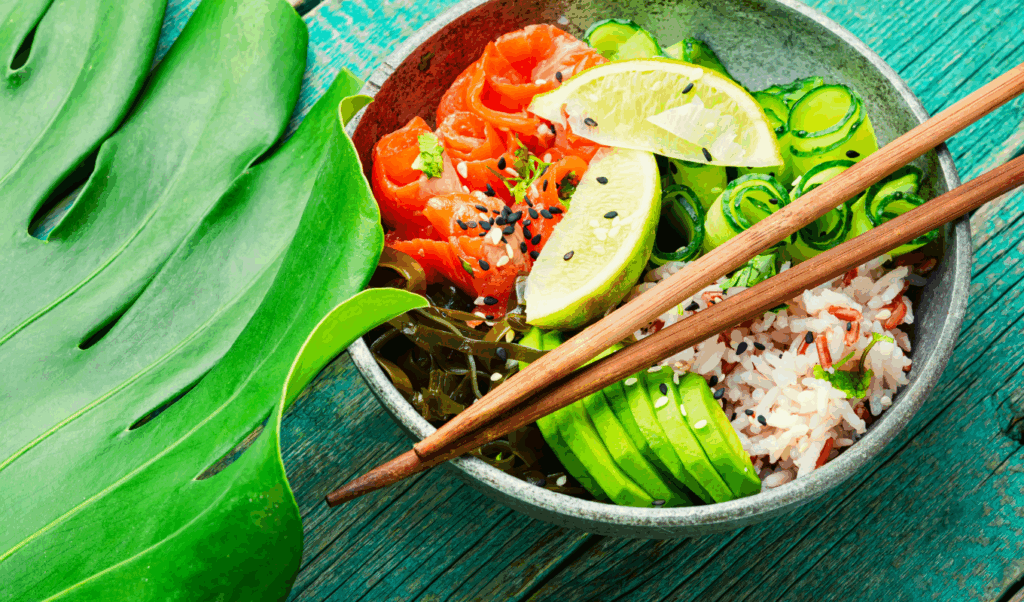
Hawaii’s Food Scene
Hawaii’s food is as vibrant and diverse as its breathtaking landscapes. The islands’ cuisine is a melting pot of traditional Polynesian flavors mixed with Asian, Portuguese, and American influences. Whether you’re grabbing a bite from a food truck or dining at a high-end restaurant, the use of fresh, local ingredients is a hallmark of Hawaiian cooking. Let’s dive into some must-try dishes, local food experiences, and island-specific recommendations that make Hawaii a true culinary paradise.
Local Hawaiian Dishes
When it comes to iconic Hawaiian dishes, poke tops the list. This beloved dish features cubed ahi tuna, seasoned with sea salt, seaweed, and onions. While the traditional preparation is a classic, modern versions often include toppings like avocado and spicy sriracha for an extra kick.
Another must-try is kalua pig, a dish steeped in tradition. Whole pigs are slow-roasted for up to 18 hours in underground ovens called imu, resulting in tender, smoky meat that practically melts in your mouth. It’s a staple at luaus and a favorite at local plate lunch spots.
For a hearty and comforting meal, loco moco hits the spot. This dish layers white rice with a hamburger patty, a fried egg, and brown gravy. Though simple, it’s incredibly satisfying and perfect for fueling a day of island adventures.
No trip to Hawaii is complete without indulging in shave ice. Unlike the crunchy texture of a snow cone, Hawaiian shave ice is finely shaved to create a snow-like consistency. Topped with colorful syrups, condensed milk, or even a scoop of ice cream, popular flavors include blue Hawaii, rainbow, and li hing mui.
And don’t forget malasadas – Portuguese-inspired donuts that have become a local favorite. These sugar-coated pastries are best enjoyed fresh and warm, and you can find filled versions with haupia (coconut pudding), chocolate, or passion fruit for a sweet twist.
Top Food Experiences
Hawaii isn’t just about the dishes – it’s about the experience of eating like a local. For starters, food trucks are a staple of the islands, serving up authentic, affordable meals. With prices typically ranging from $8 to $15, they’re a great option for enjoying local flavors without breaking the bank.
Farmers markets are another must-visit. Here, you’ll find tropical fruits like dragon fruit, rambutan, and apple bananas, alongside local honey, homemade jams, and freshly prepared foods like poke. It’s a delicious way to support local farmers and discover flavors you won’t find anywhere else.
If you’re looking for hearty portions, check out plate lunch shops. These casual spots serve meals that usually include a protein, two scoops of rice, and macaroni salad, all for about $10 to $12. It’s comfort food, Hawaiian-style.
For those craving something more refined, Hawaii’s farm-to-table restaurants deliver upscale dining experiences. These establishments highlight local ingredients like freshly caught fish, grass-fed beef, and island-grown produce. While pricier than casual options, they offer a sophisticated take on Hawaiian cuisine.
Island-Specific Food Recommendations
Each island in Hawaii has its own culinary gems worth seeking out:
- On Oʻahu, head to Giovanni’s Shrimp Truck on the North Shore for garlic shrimp served with rice, priced around $14. For dessert, Leonard’s Bakery in Honolulu is the go-to spot for freshly made malasadas.
- Maui is home to the renowned Mama’s Fish House in Paia. This oceanfront restaurant sources fish directly from local fishermen, even listing the angler’s name on the menu. Dinner entrees range from $35 to $65, but the quality and atmosphere are unmatched.
- Over on Kauaʻi, Hamura Saimin Stand is the place to try saimin, a Hawaiian-style noodle soup, with bowls costing less than $10. For something sweet, Lappert’s Ice Cream offers tropical flavors like coconut and passion fruit.
- The Big Island is famous for its Kona coffee and fresh seafood. Visit a Kona coffee farm to taste beans grown in volcanic soil, or stop by local fish markets for ahi and mahi-mahi. Da Poke Shack in Kailua-Kona is a standout, serving generous portions of poke starting at $12 per bowl.
Hawaii’s food scene is a reflection of its rich history, diverse cultures, and love for fresh, local ingredients. Whether you’re savoring a traditional dish or exploring a new flavor, every bite is a celebration of the islands’ unique culinary heritage.
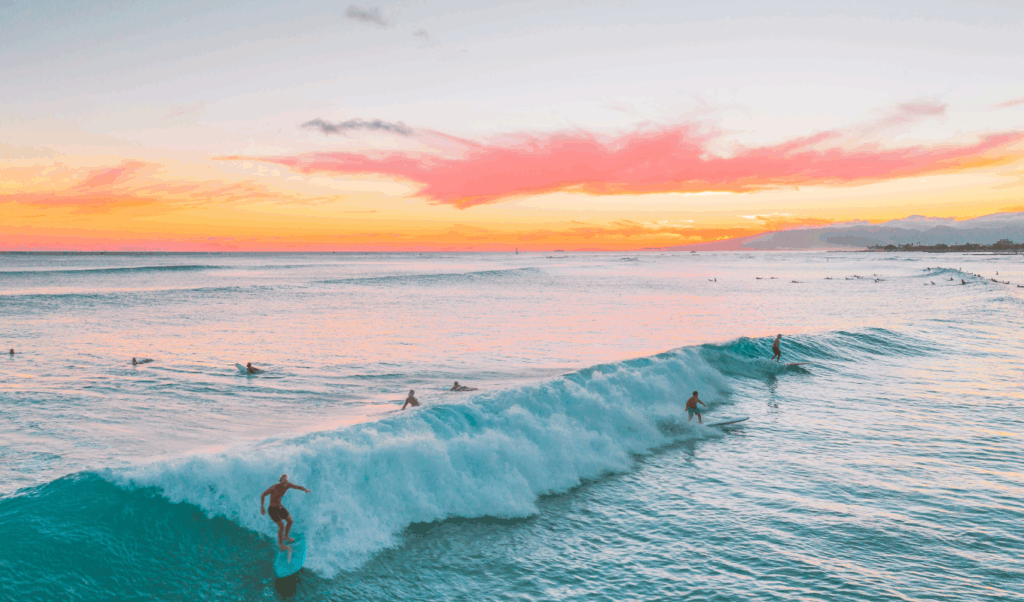
Conclusion
Hawaii offers an extraordinary mix of stunning landscapes, rich traditions, and thrilling activities, making it a dream destination for travelers worldwide. Each island has its own charm – whether it’s the volcanic wonders of the Big Island or the breathtaking Na Pali Coast on Kauaʻi, there’s something special waiting at every turn.
The secret to a smooth Hawaiian getaway? Thoughtful planning and good timing. Visiting during late spring or early fall – Hawaii’s “shoulder seasons” – can help you save on lodging while still enjoying fantastic weather. Booking flights, rental cars, and popular activities well in advance ensures your trip runs seamlessly, letting you focus on soaking in the beauty of the islands.
While inter-island travel may add to your expenses, it also opens the door to Hawaii’s wide variety of adventures. From snorkeling in the pristine waters of Molokini Crater to navigating the winding Road to Hana or witnessing lava flows at Hawaii Volcanoes National Park, the experiences are well worth the cost.
Airfare prices often depend on the season, with peak times commanding higher rates. Services like Dollar Flight Club can help you snag discounted tickets, keeping your trip within budget. By staying alert to deals and aligning your budget with thoughtful planning, you can make your Hawaiian adventure both unforgettable and affordable.
Whether you’re planning a short Oʻahu getaway or a week-long island-hopping journey, Hawaii’s unique mix of relaxation and adventure promises an incredible vacation. Start planning early, keep your travel dates flexible, and jump on flight deals when they pop up – your Hawaiian paradise is ready and waiting.
FAQs
What are the most affordable ways to travel between the Hawaiian islands?
The cheapest way to travel between Hawaiian islands is by booking inter-island flights, which usually cost between $39 and $125, depending on the route and how early you book. These flights are fast, frequent, and a go-to option for island hopping.
For a more scenic and budget-friendly alternative, consider the Maui-Lanai Passenger Ferry. Priced at about $30 one-way, it provides a picturesque ride between Maui and Lanai. While ferries aren’t as widely available as flights, they offer a unique and enjoyable travel experience.
How can I enjoy Hawaii’s cultural events while avoiding peak-season crowds?
If you’re looking to soak in Hawaii’s events without dealing with the hustle and bustle of peak-season crowds, consider visiting in September or October. These months usually attract fewer tourists, giving you a more laid-back and enjoyable experience.
For an even calmer vibe, try attending events on weekdays or during the early mornings, as these times tend to be less crowded. Steer clear of major holidays and school vacation times, like summer and winter breaks, when the islands are typically at their busiest.
What are some hidden gems and unique activities to explore in Hawaii?
Hawaii is brimming with hidden gems and one-of-a-kind experiences that take you far from the usual tourist trail. For a more tranquil beach day, check out Halona Beach Cove (famously known as From Here to Eternity Beach) or the pristine Makalawena Beach on the Big Island. If you’re up for some adventure, explore the mysterious Mermaid’s Cave on Oahu or take a hike to the secluded Pololu Valley, where you’ll be rewarded with stunning, panoramic views.
Looking for something out of the ordinary? Consider shark freediving off Oahu’s coast for a thrilling experience, or paddle your way to the Mokulua Islands by kayak. For those who love nature’s quieter side, discover hidden waterfalls or soak in the peaceful beauty of Kaena Point. These off-the-beaten-path spots let you savor Hawaii’s natural wonders in a more intimate way, creating memories you won’t soon forget.

